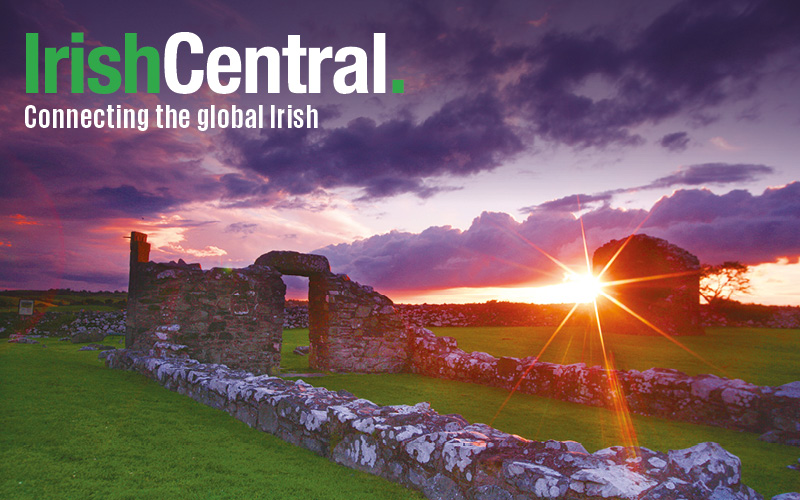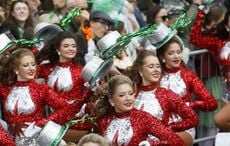AS the summer season approaches Labor Day and most of the outdoor Irish festivals have happened already save for some September events where usually the best weather awaits, I am looking back at some general notions about what makes some festivals tick. Spurred on by some debate out in the Midwest about the "rockification" of Irish festivals raised by the Irish American News trad music columnist Bill Margeson, it got me thinking about some trends that are out there shaping decisions made by respective committees.
You're seen this old codger complain about sound bleed from tent stage to tent stage, and maybe wondered if I should turn down the hearing aid in one ear and turn it up in the other depending of sound flow.
But we know the hard reality of the outdoor festival is that in order to draw crowds and increase the profits, it has to appeal to different generations and tastes. Yet a sense of balance seems to be missing. Margeson warns that the over-30 crowd is being chased away from the proliferating Celtic festivals run by less culturally motivated committees who focus on Celtic rock bands to draw the twenty-something demographic fans who top up the beer sales.
The resulting profit creates a very competitive cycle that may help the short-term aim of the festivals, but at the price of sacrificing the cultural transmission that gave many of the festivals their start and even driving up the cost of providing such entertainment.
I am beginning to sense that there is something amiss here beyond the predictable generational divide that separated me from my parents and the Beatles, though still allowed us to appreciate the Clancy Brothers and Tommy Makem together.
I don't expect those tensions or the debate to end any time soon, but it does make me appreciate some hardy perennials that reinforce my trad-world existence (some would say cocoon) that provides plenty of variety and talent that still stimulates and reflects a very high standard of cultural development in the Irish music scene.
As I get further and further away from the 2007 Catskills Irish Arts Week held in East Durham, I am able to be a little more objective about why it appeals to so many who keep the week alive in a very challenged environ.
Serving as the artistic director before, during and after is all consuming, but I try to step out of that mantra to take in the reactions of the teachers, students and fans of the music who still keep flogging to the upstate village where trad music and dance are paramount for one Brigadoon-like week each summer.
Comments about it being the best year yet are delivered with a smile and sense of enjoyment that transcends issues like modern accommodations, driving from place to place and sleep deprivation.
Much of that sleep deprivation was due to the insatiable sessions around town leading to the almost 24/7 nature of the week, enhanced this year by the Oak Hill Kitchen's decision to stay open 24 hours with their healthy food offerings in a non-alcoholic and bucolic indoor woodsy setting. And Luisa Bennion helped caffeinate folks at all hours with her outdoor upmarket cafe stall outside the equally hospitable Furlong's Pub.
But it was the hard-core focus on solid traditional music all week through classes that reached out to 600 students, followed by no less than nine special lectures or master classes on top of that making for some serious learning by folks of all ages, including a husband and wife in their seventies and eighties who traveled all the way from North Carolina (one of 30 states represented on the student roster).
All week long the evening started off with concerts featuring a staff that totaled 75 performers on the Michael J. Quill Irish Festival Grounds in their outdoor pavilion that averaged crowds of 500 per night, while 100 more or so pounded the hardwood floors every night in the Shamrock or the Weldon House to shape up ceili bands drawn from the faculty.
These seemed to serve as starters to the main course of more than 40 sessions throughout the week in the regional roadhouse that tested the fortitude but not the familiarity with much of the star-studded cast led by icons like Jackie Daly, Mary Bergin, Matt Cranitch, Kane Sisters, Catherine McEvoy, Chris Droney, Billy McComiskey, Brian Conway and the Mulcahy Family to name just a few. Even Joanie Madden found time to swing up for a day's craic and fit in enough music in a few hours to last some others a week.
It seems odd to say that in its 13th year the Catskills Irish Arts Week found a rhythm and balance that was almost on autopilot, and that is only because it attracts enough people who want to be there to make it a going concern.
With the further advantage of the Quill Center carrying out its cultural mandate as a non-profit which allowed for funding from Culture Ireland, the New York State Music Fund, New York State Council on the Arts, the Irish Institute in New York City and a host of other sponsors, there was no need in trying to attract those who didn't share the love of traditional music there for curiosity or profit sake.
The economic benefits are plain to see, and they helped spark the upcoming Banjo Burke Festival (www.joebanjoburke.org) on Columbus Day weekend and later in October at Halloween, the Northeast Piping Tionol (www.eastcoastpipers.com) also in East Durham.
Out in Milwaukee over the weekend of August 16-19, as I reported last week, some showers dampened the Henry W. Maier Festival Park (truly the finest facility for this purpose that I have experienced) on the critical Saturday and Sunday closing days.
In spite of that nearly 100,000 people turned up over the four days to sample an amazing group of musicians and acts that make this the leading Irish festival in the world on many fronts.
While beer sales do make up an important component of their annual profit, most people are impressed with the lack of excessive or rowdy behavior especially given its ready availability in this city where beer made Milwaukee famous.
What makes this festival stand out after 27 years is an intense commitment to reflect the changing relationship with Ireland, America and its Celtic cousins like Scotland and Cape Breton, while holding onto an appreciation for the cultural past, present and future.
Granted 80 acres of state of the art fixed festival facilities gives them quite a head start, but it is the creative forces behind the festival along with its unrivalled volunteer corps of 4,000 workers that will always keep them ahead of the pack and entertainers vying to come here to perform.
Inviting in Joanie Madden and Cherish the Ladies for a special reunion in their 20th year as a road act seems an easy thing to do, but few festivals can match that with similar programming options that allow the cast to swell and truly reflect the amount of talent out there on the trad scene.
Even a fine duo like Liz Carroll and John Doyle can reach behind stage and call on the likes of John McCusker, Alan Kelly (who were part of Eddi Reader's Band) or Jackie Moran (of Gan Bua) to have a few tunes making for even more memorable music.
Rising young bands like the David Munnelly Band pound out driving music, with equally impressive vocals from their new singer Shauna Mullen from Donegal or the multi-talented Beoga's fresh sounds sparked by one of the finest young singers you will hear anywhere in Niamh Dunne from the famed Dunne family in Limerick.
Reaching out for the future while respecting the past is a hallmark of the Milwaukee Irish Fest, and that is just a tip of the entertainment selections featured this year.




Comments